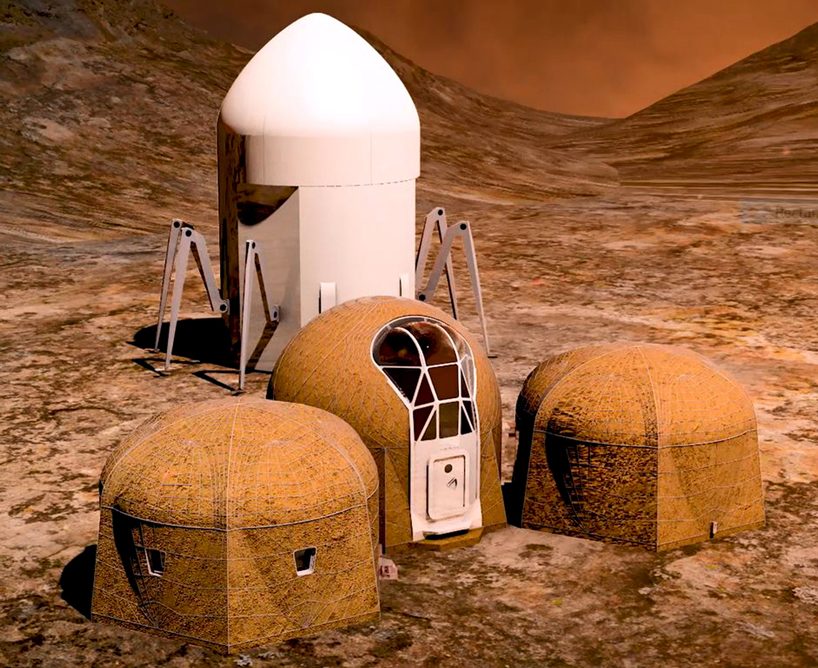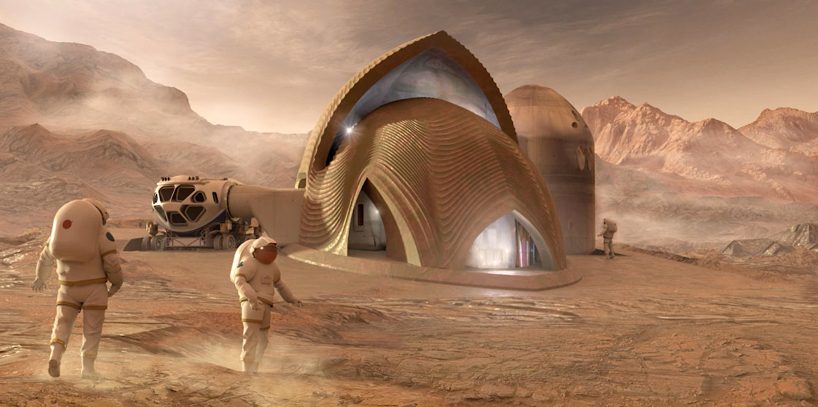NASA has selected the five winning designs in the latest stage of its 3D-printed habitat competition, including a pod inspired by the anatomy of a spider and vertical egg-like container. teams were challenged to come up with a solution that tackled the issues of transporting materials to mars, considering differences in atmosphere and landscape on the red planet. nasa-mars-3d-habitat-competition-winners-centennial-challenge-07-30-2018

arkansas-based team zopherus propose a spider-like lander to host the 3D-printed process from an internal chamber
the multi-phase competition challenged designers and engineers to use construction techniques enabled by 3D printing technology. the shelter had to include a thousand square feet of space, enough to accommodate four astronauts on a mission to mars as well as a room to store the necessary machinery. each team was required to create digital representations of the physical and functional characteristics of a house on mars using specialised software tools.
videos by NASA’s marshall space flight center
first place in this stage went to arkansas-based team zopherus who proposed a spider-like lander to host the 3D-printed process from an internal chamber. after landing the pod would scanning its surroundings before selecting an optimum print area, assisted by a series of autonomous robots who would gather materials like ice, calcium oxide and martian aggregate, for the 3D printer. the lander seals to the ground to provide a protected, pressurised environment for the structure to be printed. once complete, the lander would lift its legs to reveal the structure and move on to the next location to build another, creating a small series of rooms.

AI spacefactory present egg-shaped structure, designed with a double shell to combat the aggressive thermal effects of mars
AI spacefactory came in second place, presenting an egg-shaped structure, designed with a double shell to combat the aggressive thermal effects of mars. like the zopherus habitat, the team envisions the marsha design to use materials sourced from mars including basalt fibre, extracted from martian rock, and renewable bioplastic (polylactic acid) derived from plants that could be grown on the planet. to read more see here.
in third place, kahn-yates designed oblong structures, designed with a perforated, high-strength plastic layer that lets the light in. the shape of the structure is intended to minimise the impact from potential dust storms. the pre-fabricated dwelling would arrive on mars within a space-faring module which would split off on landing. an integrated print arm would then print a concrete shell, while secondary nozzles print HDPE (high-density polyethylene) layers on either side of the shell.
in fourth place SEArch+/Apis Cor, submitted a habitat that carefully considers its position and shape to maximize light whilst protecting against radiation exposure. finally fifth place, designed by northwestern university, uses an inflatable vessel as the base for the printer to create a double-shell design featuring a unique spherical shell and outer parabolic dome. it’s built using a sloped site expanding the amount of possible locations on the uneven martian terrain.

SEArch+/Apis Cor submitted a habitat to maximize light whilst protecting against radiation exposure
NASA launched the 3D-printed habitat challenge back in 2015 to find suitable artificial accommodation concepts for the first wave of martian residents. the five winners set to build scale models next year. the winners, who were ranked using a point system, were selected by NASA in partnership with bradley university of peoria, illinois, out of 18 groups from around the world. they will all share part of a $100,000 prize depending on the score achieved. the winners are set to build scale models next year.
‘we are thrilled to see the success of this diverse group of teams that have approached this competition in their own unique styles,’ said monsi roman, programme manager for NASA’s series of centennial challenges. ‘they are not just designing structures, they are designing habitats that will allow our space explorers to live and work on other planets. we are excited to see their designs come to life as the competition moves forward.’
No hay comentarios:
Publicar un comentario